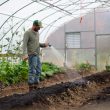Six ways states could help cities and towns implement climate solutions
Cities, towns and regions are creating jobs, improving health and making communities more livable. Many of them are doing so as part of their strategy to address climate change. This is an approach called “multisolving,” and examples of it are becoming more common.
Case in point: Home weatherization programs reduce greenhouse gas emissions and provide good jobs. They also save money for residents. A program in Nashville, Tenn., cut residents’ utility bills by 25 percent. And well-insulated homes are more resilient, staying comfortable longer in power outages.
Also, 19 states now have pilot programs to scale up electric school buses, which produce less pollution. They also help clear the air, a health win for children. Their batteries bolster the electric grid and serve as mobile electricity sources during outages.
Solar power installations provide communities with both clean energy and economic opportunity. These installations can be paired with other enterprises. Crops can grow in the partial shade of the panels and animals can be pastured around them. Such agri-voltaic projects conserve water, provide habitat and boost the agricultural economy. A project in California covers canals with solar panels, generating clean energy while conserving water by preventing evaporation.
Despite its promise, cities, regions and utilities face obstacles in tapping the power of multisolving. They have limited budgets. Jurisdictional and municipal boundaries can get in the way of synergistic solutions. Heavy workloads prevent leaders from connecting across sectors or municipalities.
Fortunately, state governments can help. Here are six ways states can help boost multisolving in their communities.
Integrate non-climate goals in state climate action
A state can lead its cities and towns by example. Can every climate project provide other benefits? Reduced GHGs or improved resilience are a given. What else can proposed projects deliver? Health? Equity? Community well-being?
Not all climate plans are equal when it comes to health and other benefits. A study on transportation in London provides a good example. Two transportation plans offered similar CO2 reductions. But investment in walkability would have prevented an additional 500 premature deaths per million people compared to a plan for more efficient vehicles. To identify the biggest multisolving opportunities, decision makers need to evaluate a range of benefits including:
- improved air quality
- more access to daily physical activity
- improved well-being from shorter commutes, more greenspace, and other amenities
- better jobs in marginalized communities
- resilience to flooding, heatwaves, and power outages.
Include climate considerations in all other projects
Start with the most pressing problems in the state. How might protecting the climate help address them?
Need to support small businesses? Help them cut their energy, water, and materials expenses with efficiency programs. Senior citizens struggling to meet their bills? Home weatherization can reduce the energy burden. Food security a challenge? Invest in ways to divert otherwise wasted food to hungry families. Or plant urban food forests that also build climate resilience.
Connect the climate change dots across agencies
A siloed state government cannot effectively support multisolving in cities and towns. To advance programs that help communities, bring together all the state-level health, transportation, jobs, climate and energy officials. Choose agency leaders based on their expertise and their skill at collaboration. Make delivering synergies part of every job description.
With multisolving, costs and benefits accrue in different domains. A weatherization project might be a cost to an energy department. But a reduced energy burden and healthier homes for residents could translate into savings for social service agencies. Without connections across agencies these synergistic benefits might never be recognized.
Bring communities together to solve problems
Multisolving solutions don’t fit neatly within typical jurisdictions or city limits. For instance, restoration of upstream wetlands can be the least-cost solution to climate-change-exacerbated flooding downstream. Upstream and downstream communities could work together on solutions that benefit both. But such partnerships need nurturing and support. States can use their convening power to connect potential partners. They can use grants and other mechanisms to help facilitate collaborations.
Provide technical and financial assistance in the early stages
It’s hard to create what you haven’t imagined, and local officials don’t always have a full understanding of the array of possibilities. Multisolving trainings, perhaps coordinated by community colleges or university extension, can help bridge this gap.
Multisolving projects also have upfront costs. Modest amounts of funding can cover the time and expense of bringing together diverse stakeholders. It takes time to build trusting relationships. It takes time for health experts to learn about climate and energy and vice versa. Small grants to support early-stage scoping, visioning and pilot projects can pay off with multisolving wins.
Support the involvement of community members
Robust community involvement ensures that burdens and benefits are shared in a just way. It guards against unanticipated side-effects and helps avoid slowdowns or opposition later in the process. But cultivating such participation requires resources. Community members might need training to understand technical details. They might need childcare, transportation or stipends to enable participation. State-wide programs could facilitate this critical involvement.
Today, many opportunities remain overlooked, but state leaders can help create the conditions for more multisolving. Small investments can unlock big wins in climate, health, equity and well-being.
Dr. Elizabeth Sawin is founder and director of the Multisolving Institute, a think-do tank that helps people implement win-win-win solutions that protect the climate while improving, equity, health, biodiversity, economic vitality and well-being. She is a biologist with a PhD from MIT who has been analyzing complex systems related to climate change for more than 20 years. You can follow her on twitter.




















